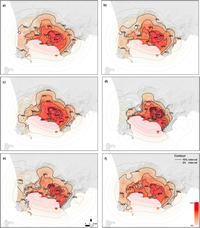Quantifying volcanic hazard at Campi Flegrei caldera (Italy) with uncertainty assessment: 2. Pyroclastic density current invasion maps
Neri A., A. Bevilacqua, T. Esposti Ongaro, R. Isaia, W.P. Aspinall, M. Bisson, F. Flandoli, P.J. Baxter, A. Bertagnini, E. Iannuzzi, S. Orsucci, M. Pistolesi, M. Rosi and S. Vitale (2015).
Journal of Geophysical Research – Solid Earth, Volume 120, Issue 4, Pages 2330–2349, doi:10.1002/2014JB011776.
Abstract
Campi Flegrei (CF) is an example of an active caldera containing densely populated settlements at very high risk of pyroclastic density currents (PDCs). We present here an innovative method for assessing background spatial PDC hazard in a caldera setting with probabilistic invasion maps conditional on the occurrence of an explosive event. The method encompasses the probabilistic assessment of potential vent opening positions, derived in the companion paper, combined with inferences about the spatial density distribution of PDC invasion areas from a simplified flow model, informed by reconstruction of deposits from eruptions in the last 15 ka. The flow model describes the PDC kinematics and accounts for main effects of topography on flow propagation. Structured expert elicitation is used to incorporate certain sources of epistemic uncertainty, and a Monte Carlo approach is adopted to produce a set of probabilistic hazard maps for the whole CF area. Our findings show that, in case of eruption, almost the entire caldera is exposed to invasion with a mean probability of at least 5%, with peaks greater than 50% in some central areas. Some areas outside the caldera are also exposed to this danger, with mean probabilities of invasion of the order of 5–10%. Our analysis suggests that these probability estimates have location-specific uncertainties which can be substantial. The results prove to be robust with respect to alternative elicitation models and allow the influence on hazard mapping of different sources of uncertainty, and of theoretical and numerical assumptions, to be quantified.
http://onlinelibrary.wiley.com/doi/10.1002/2014JB011776/full


